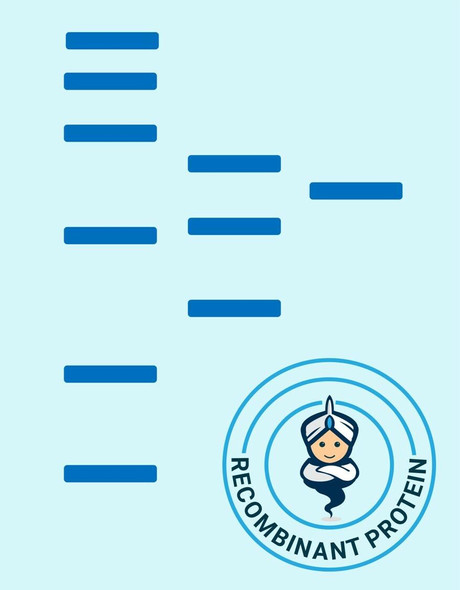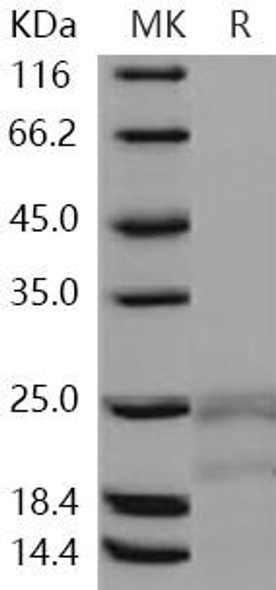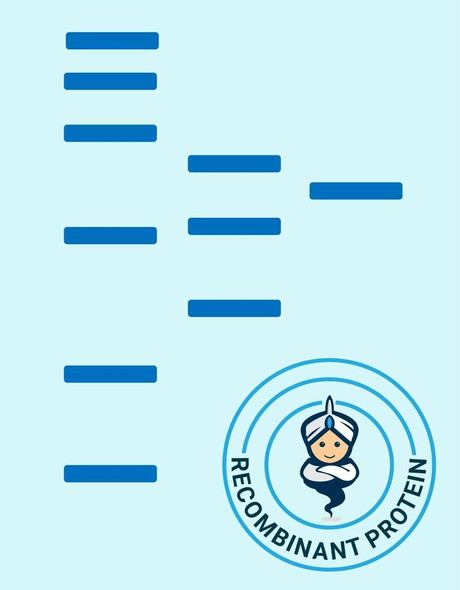Human IFNG Recombinant Protein (RPPB0398)
- SKU:
- RPPB0398
- Product Type:
- Recombinant Protein
- Species:
- Human
- Uniprot:
- P01579
- Research Area:
- Cytokines
Description
| Product Name: | Human IFNG Recombinant Protein |
| Product Code: | RPPB0398 |
| Size: | 10µg |
| Species: | Human |
| Target: | IFNG |
| Synonyms: | Immune Interferon, type II interferon, T cell interferon, MAF, IFNG, IFG, IFI, IFN-gamma. |
| Source: | Escherichia Coli |
| Physical Appearance: | Sterile Filtered colorless liquid. |
| Formulation: | IFNG protein solution (1mg/ml) containing Phosphate buffered saline (pH 7.4) and 20% glycerol. |
| Stability: | Store at 4°C if entire vial will be used within 2-4 weeks. Store, frozen at -20°C for longer periods of time. For long term storage it is recommended to add a carrier protein (0.1% HSA or BSA).Avoid multiple freeze-thaw cycles. |
| Purity: | Greater than 90.0% as determined by SDS-PAGE. |
| Amino Acid Sequence: | MGSSHHHHHH SSGLVPRGSH MQDPYVKEAE NLKKYFNAGH SDVADNGTLF LGILKNWKEE SDRKIMQSQI VSFYFKLFKN FKDDQSIQKS VETIKEDMNV KFFNSNKKKR DDFEKLTNYS VTDLNVQRKA IHELIQVMAE LSPAAKTGKR KRSQMLFRG |
| Biological Activity: | Measured in a cytotoxicity assay using WiDr cells. The ED50 for this effect is ? 5 ng/ml. |
IFN-gamma produced by lymphocytes activated by specific antigens or mitogens.IFN-gamma, in addition to having antiviral activity, has important immunoregulatory functions, it is a potent activator of macrophages, and has antiproliferative effects on transformed cells and it can potentiate the antiviral and antitumor effects of the type I interferons.
IFNG Human Recombinant produced in E.Coli is a single, non-glycosylated polypeptide chain containing 159 amino acids (24-161 a.a) and having a molecular mass of 18.4kDa. IFNG is fused to a 21 amino acid His-tag at N-terminus & purified by proprietary chromatographic techniques.
| UniProt Protein Function: | IFNG: Produced by lymphocytes activated by specific antigens or mitogens. IFN-gamma, in addition to having antiviral activity, has important immunoregulatory functions. It is a potent activator of macrophages, it has antiproliferative effects on transformed cells and it can potentiate the antiviral and antitumor effects of the type I interferons. Homodimer. Released primarily from activated T lymphocytes. Belongs to the type II (or gamma) interferon family. |
| UniProt Protein Details: | Protein type:Membrane protein, integral; Secreted; Secreted, signal peptide; Cytokine Chromosomal Location of Human Ortholog: 12q14 Cellular Component: extracellular space; extracellular region; external side of plasma membrane Molecular Function:interferon-gamma receptor binding; cytokine activity Biological Process: positive regulation of isotype switching to IgG isotypes; positive regulation of nitric oxide biosynthetic process; apoptosis; positive regulation of interleukin-23 production; negative regulation of smooth muscle cell proliferation; positive regulation of interleukin-12 production; positive regulation of osteoclast differentiation; positive regulation of interleukin-6 biosynthetic process; negative regulation of epithelial cell differentiation; positive regulation of interleukin-1 beta secretion; positive regulation of killing of cells of another organism; negative regulation of transcription from RNA polymerase II promoter; sensory perception of mechanical stimulus; positive regulation of membrane protein ectodomain proteolysis; cell surface receptor linked signal transduction; positive regulation of MHC class II biosynthetic process; positive regulation of cell proliferation; positive regulation of mesenchymal cell proliferation; positive regulation of T cell proliferation; cell cycle arrest; defense response to virus; regulation of the force of heart contraction; positive regulation of peptidyl-serine phosphorylation of STAT protein; response to drug; positive regulation of synaptic transmission, cholinergic; neutrophil chemotaxis; adaptive immune response; CD8-positive, alpha-beta T cell differentiation during immune response; negative regulation of myelination; unfolded protein response; response to virus; cytokine and chemokine mediated signaling pathway; defense response to protozoan; positive regulation of tumor necrosis factor production; humoral immune response; antigen processing and presentation; positive regulation of tyrosine phosphorylation of Stat1 protein; positive regulation of chemokine biosynthetic process; negative regulation of interleukin-17 production; positive regulation of interleukin-12 biosynthetic process; protein import into nucleus, translocation; defense response to bacterium; neutrophil apoptosis; positive regulation of transcription from RNA polymerase II promoter; cell motility; positive regulation of neuron differentiation; regulation of insulin secretion Disease: Hepatitis C Virus, Susceptibility To; Aplastic Anemia; Tuberous Sclerosis 2; Mycobacterium Tuberculosis, Susceptibility To; Human Immunodeficiency Virus Type 1, Susceptibility To |
| NCBI Summary: | This gene encodes a member of the type II interferon family. The protein encoded is a soluble cytokine with antiviral, immunoregulatory and anti-tumor properties and is a potent activator of macrophages. Mutations in this gene are associated with aplastic anemia.[provided by RefSeq, Nov 2009] |
| UniProt Code: | P01579 |
| NCBI GenInfo Identifier: | 124479 |
| NCBI Gene ID: | 3458 |
| NCBI Accession: | P01579.1 |
| UniProt Secondary Accession: | P01579,Q53ZV4, B5BU88, |
| UniProt Related Accession: | P01579 |
| Molecular Weight: | |
| NCBI Full Name: | Interferon gamma |
| NCBI Synonym Full Names: | interferon, gamma |
| NCBI Official Symbol: | IFNG�� |
| NCBI Official Synonym Symbols: | IFG; IFI�� |
| NCBI Protein Information: | interferon gamma; IFN-gamma; immune interferon |
| UniProt Protein Name: | Interferon gamma |
| UniProt Synonym Protein Names: | Immune interferon |
| Protein Family: | Interferon |
| UniProt Gene Name: | IFNG�� |
| UniProt Entry Name: | IFNG_HUMAN |










